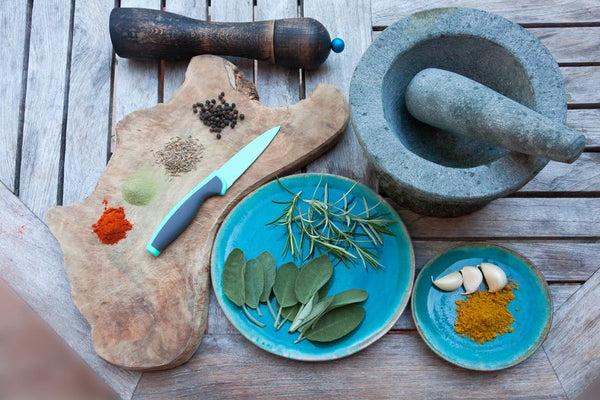There has been a lot of buzz around trendy new diets, super-foods, workouts, and even eating plans (read: intermittent fasting) in recent years. To be honest, I have tried a few of them and actually seen great results…except for that those results are usually fleeting. Instead of a trendy new diet or 30-day plans, I focus on a science and lifestyle that has been around for over 5,000 years and works.
That science is called Ayurveda, which literally means the science of knowledge of life. Ayus - means life, and Veda - means knowledge. The purpose of this science was to lead mankind toward optimal health. The creators knew that humans could find balance in body, mind, and spirit by connecting with nature and gaining a great understanding of the nature of our selves. My goal is to resurface the beauty and power of this science and bring it into modern day context.
Let's start with doshas, or energy types.
In nature, there are five elements, and each element has its own energy type:
- Earth - is grounding and stable.
- Water - is fluid and flowing.
- Fire - is sharp and transformative.
- Air - is light and dry.
- Ether - is open and vast.
Every living thing is made up of a unique combination of the elements, and every human being is made up of a combination of these elements. To better understand them, the science presents the doshas. Two elements combined equal one dosha. Therefore, Earth + Water= Kapha, Water+ Fire= Pitta, Air + Ether= Vata.
We can describe our physical structure, personalities, physiological functions, daily habits, etc., all through the doshas.
Those with more Vata energies: air and ether—will have light, unstable, cold nature to them. Their physical structures typically include slight frames, long limbs, and a thin appearance. Their personalities are bubbly, enthusiastic, creative, indecisive, and forgetful. When out of balance, Vatas get bloated, gassy, less bowel movements, and dry skin.
People with more Pitta energies: fire and little bit water, will be hot and sharp. Their physical structures include muscular structures with even/symmetrical proportions. Their personalities are goal-oriented, workaholics, and competitive. They have strong appetites, but out of balance they have the tendency to develop burning indigestion and are prone to acne.
Those with more Kapha energies: earth and water, are stable, heavy, dense. Kaphas have strong physical structures, are bigger boned, and have stockier or curvier features. Their personalities are sweet, dependable, and stubborn. They have low appetites, and when out of balance, they have sluggish digestion and like to oversleep.
Although life doesn’t work out in stereotypes, it helps us to grasp concepts. Every human being has a unique makeup of each of the doshas and at any time can find his or herself resonating more toward one of the elements. If you're not sure which dosha you resonate most with, you can find many quizzes online (we recommend https://banyanbotanicals.com/info/dosha-quiz/ or https://eatfeelfresh.com/new-quiz/).

Why Ayurveda instead of other lifestyles or diets?
Ayurveda is specialized for your body and mind. Everyone has a unique make-up of the elements and even if someone shares the same dosha, their approach towards optimal health will look different. For example, two people who are Vata may have anxiety. However, one works night shifts at a restaurant and the other has had a traumatic car accident. What is important for healing their imbalances will look completely different.
This explains why some diets or eating techniques work really well for some people, but others get frustrating results or feel even worse, despite "clean" or "healthy" eating.
How to start eating for your dosha type.
At a high level, eating Ayurvedically is very intuitive. All it takes is a little self-awareness and the willingness to listen to our own bodies. If you think about the main elements of your nature, you can then understand that nourishing your body with opposing elements will help bring your body into harmony. For example, if you are naturally dry, thin, and cold, you can balance out those qualities by choosing foods that are naturally moist, dense, and warming.
There are also foods that are great for all dosha types.
These foods are labeled as 'tridoshic', meaning they do not aggravate or throw any of the doshas out of balance. Examples are foods like basmati rice and mung beans, which are typically cooked together in a dish called Kitchari in Indian cuisine. Spices are also tridoshic, and some examples include: cumin, coriander, fennel, and Triphala. Spices are an incredible way to not only spruce up your recipes, but also to truly embrace the mantra that food is medicine.
On the contrary, there are foods that are not great for any dosha type.
These will come as no surprise, but processed, fried, and sugary foods cause imbalances for all doshas. The reason is that in Ayurveda, food is seen as energy or ojas. When food is fried or ultra-processed, nutrients are stripped away, leaving only toxins. Over time, toxin build-up depletes our ojas and makes us prone to disease.
In Ayurveda, how well the body digests food is equally, if not more, important than what we eat. So although it is important to be mindful of our food choices, our routines and habits around eating hold even more importance.
How Ayurveda views food and disease.
There are three main causes of disease; time and motion, failure of intellect and misuse of the senses. Although all of these causes affect our relationship with food, misuse of our taste sense is a common misperception. In Western nutrition, food is viewed as carbs, proteins or fats. In Ayurveda, food is viewed as an opportunity to bring healing through our sense of taste. Since the science is based on the elements, Ayurveda has created six tastes, each representing two elements:
- Sweet
- Salty
- Sour
- Bitter
- Astringent
- Pungent
Therefore, each dosha should favor three of the tastes while incorporating all six into every dish. Vata's should favor the salty, sweet and sour. Pitta's should favor the sweet, bitter and astringent. Kapha's should favor the pungent, bitter and astringent.
One new Ayurvedic habit you can implement today.
Before you pull out the list of foods that are best for your dosha (looking at you Pittas), start by implementing one new daily routine. We recommend drinking warm water every morning upon waking. If you're more Vata or Kapha, squeeze 1/4 of a fresh lemon into your water to fire up your digestive fire. If you are more Pitta, squeeze 1/4 of a lime for a more cooling and detoxifying effect. Once you master this, focus on one taste at a time to connect with your food on a deeper level.
Peace, love, and healing,
Angelica
P.S. If you are interested in learning more, set up a free coaching call with Angelica :)
 My passion for holistic health is rooted in my love for yoga. I began practicing yoga in 2011, which shed a beacon of light onto my true path. As I continued to further my personal practice, I unveiled the realization that my purpose was to educate others. I received my 200-hr Power Yoga Teacher Training in 2015 and expanded my consciousness even more. A whole new world was presented to me.
My passion for holistic health is rooted in my love for yoga. I began practicing yoga in 2011, which shed a beacon of light onto my true path. As I continued to further my personal practice, I unveiled the realization that my purpose was to educate others. I received my 200-hr Power Yoga Teacher Training in 2015 and expanded my consciousness even more. A whole new world was presented to me.
